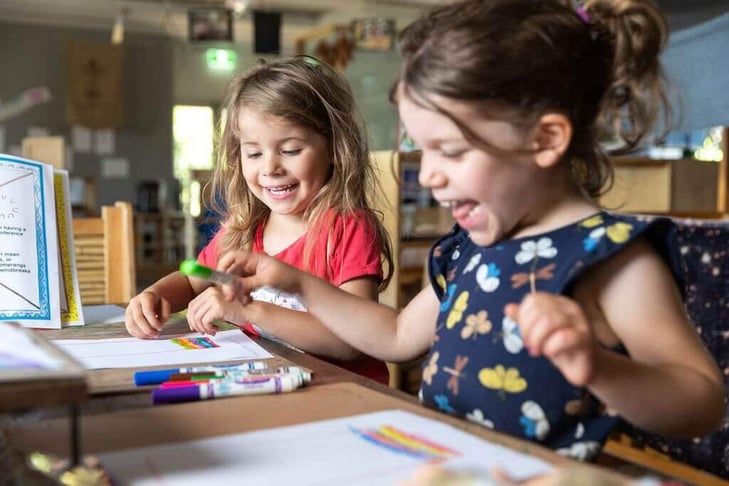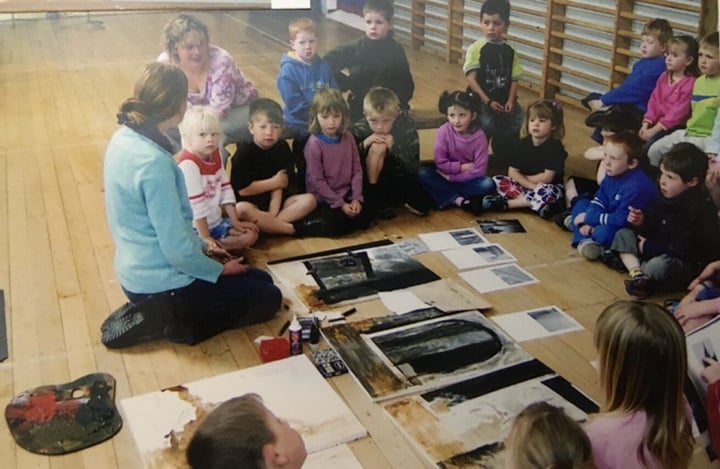Key Points:
- Creative Arts are significant in enlarging human understanding – Elliot Eisner
- Early Years Learning Framework for Australia holds creativity as foundational in the practice of ‘learning through play’.
- How the arts can be powerful tools for our own professional inquiry as early childhood professionals?
Working with pictures to make meaning of concepts
Since childhood, and throughout adulthood, I have always worked with pictures to make meaning of concepts that feel complex and at times confusing. I remember distinctly, at the age of nine and faced with the challenge of my maths homework, my determination to understand led me to a process where I drew with the brightest colours I could find on a large piece of blank white paper. By mapping out the information and making connections between different parts of an equation – I came (sometimes not knowing how) to an answer.
My personal experience highlights how the arts are significant in enlarging human understanding because they allow knowledge to be constructed in multiple ways and through different forms (Eisner, 2008). This is echoed in the Early Years Learning Framework for Australia which holds play and creativity as being foundational in the practice of ‘learning through play’. Learning through play acknowledges that rich and deep learning occurs through discovery, creativity, improvisation, and imagination. (Council of Australian Governments, 2009).
However, what do these words mean for teachers and educators?
How can the underpinning views of learning (as seen in the Early Years Learning Framework) add depth to and support for our own pedagogical thinking?
 Powerful tools for professional inquiry
Powerful tools for professional inquiry
Investigating how the arts can be powerful tools for our own professional inquiry and processes of reflection informs the questions that underpin my current research. These are questions that I have held for some time within my own teaching practice and even long before I became a teacher.
Before becoming a teacher, I had trained as an artist at Otago School of Art in New Zealand and this aspect of my being was (and still is) integral to how I view and make sense of my world. I painted, I drew, I wove, and I created collages comprised of multiple layers such as paint, impasto, charcoal and diverse textures like wallpaper, fabric, and found objects. It was through the modality of mixed-media drawing that I was able to use the surface of the image to tell a story and draw the viewer into a time past and forgotten. The creative process took time because with each new layer added, I would have to wait for the previous one to dry. It was this waiting and pausing that allowed me to engage with the process, to uncover new meanings and understandings of the concepts behind my artmaking.
As an artist, my creative process involved playing, experimenting, and making mistakes. To me, this mode of creative inquiry is akin to ways that my identity as an early childhood teacher formed. When I look back and reflect on my teaching identity, I can see a defined pathway to where I am now and who I am now. My sense of self, as an early childhood practitioner is comprised of many different parts - some new and some old. One experience that I still reflect on, was an opportunity to participate in an artist in residence at a small country school in North Otago, New Zealand. At this time, I didn’t realise that this experience would be a pivotal point in the formation of my identity as a teacher, but it was.

Studio Discussion with the children and teachers at Fenwick Primary School, New Zealand, 2003.
Engaging creatively and expressively with teachers and students
Through engaging creatively and expressively with the teachers and students at this school I began to make clear links to how the arts are necessary for deep learning (Ewing, 2020, personal communication) and provide, the means for children to learn, to develop relationships, to begin defining who they are and who they might become (O’Connor, 2020). Elliot Eisner (2002) also reminds us that the arts are integral to learning because they provide learners with multi-modal tools for making meaning about the world:
“The arts make vivid the fact that neither words in their literal form nor numbers exhaust what we can know. The limits of our language do not define the limits of our cognition” (p.70-92).
I hold Eisner’s thoughts as highly important for an early childhood context because in early childhood a broad range of age groups (birth to school age), as well as differing stages of development, are represented. This means that children’s expressions of learning are diverse, and a wide range of teaching approaches are essential in our teaching ‘tool-kits’.
Educators draw on 'creativity, intuition and imagination'
The Early Years Learning Framework emphasises that when educators draw on “creativity, intuition and imagination” – their practices are able to be improvised on and adjusted to be relevant to their specific learning context. (Council of Australian Governments, 2009, p.11).
In early childhood education, play provides the opportunity for children to question, problem solve and engage in processes of critical thinking.
Just as children discover through creative processes of play, the time and space for adults to engage in processes of creative inquiry - to grapple with deep pedagogical questions and engage in processes of critical thinking are essential for our unfolding sense of professional self. I wonder if after reading my reflection you will be inspired to explore the tools of artmaking like painting, drawing, clay work, and collage to reflect creatively on your teaching practice? Perhaps through this process, new insights about teaching and learning will be the result.
Author: Jessica Horne-Kennedy
References:
Council of Australian Governments. (2009). Belonging, Being and Becoming: The Early Years Learning Framework for Australia. Department of Education, Employment and Workplace Relations.
Eisner, E. (2002). The Arts and the Creation of Mind. Yale University Press.
Eisner, E. (2008). Art and Knowledge. Handbook of the Arts in Qualitative Research: Perspectives, Methodologies, Examples, and Issues. In: J.G.Knowles & A.L.Cole (Eds.) (pp. 3-12). Sage.
O’Connor, P. (2020, December 10). The Bigger Context. Te Rito Toi. https://www.teritotoi.org/the-bigger-context/




